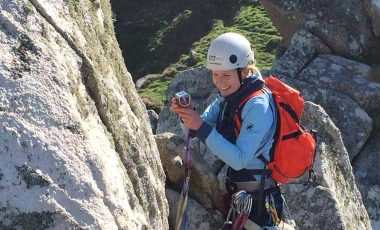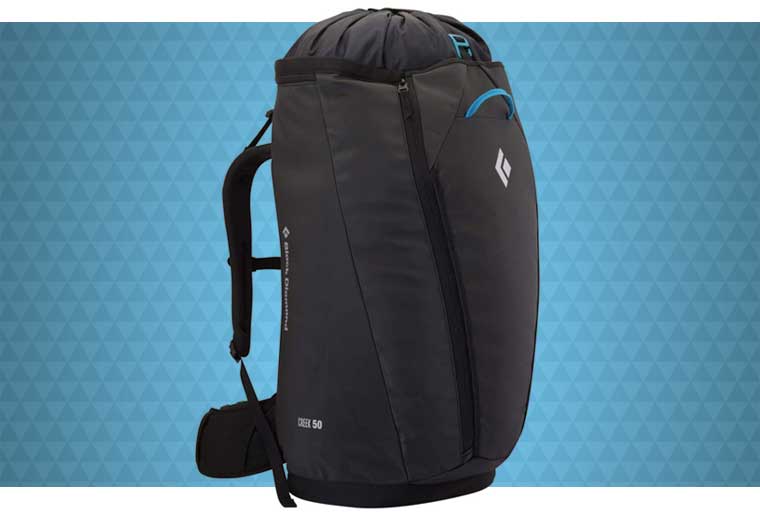Like any outdoor gear item, certain models of backpack are better suited to different types of activity. When your activity type happens to be climbing, using your standard hiking backpack isn’t quite like taking a knife to a gunfight but at least akin to using a cheese knife on a meaty slab of steak — it might do the job, but not without a bit of a struggle and lots of unnecessary pfaffing around.
In this article, we hope to help you spare yourself all the struggles, pfaffing about, and other hassles that may come from using a non-climbing pack in a climbing environment. We’ll start by giving you the lowdown on the types of climbing packs out there, then move on to an analysis of all the features and characteristics to look out for and a review of our pick of the best climbing packs out there for 2024.
The best climbing packs for 2024
Disclaimer: We use affiliate links and may receive a small commission on purchases.
| Product | Type of pack | Features | Weight | Cost |
|---|---|---|---|---|
| Deuter Durascent 30 Backpack | Alpine pack | Waterproof, simple design | 730g / 1.6 lbs | $$$$$ |
| Osprey Mutant 38-Liter Backpack | Alpine pack | Very comfortable, lots of features | 1134g (40oz) | $$$$ |
| Patagonia Ascensionist 30 Pack | Alpine pack | Hard wearing, comfortable | 669g (23oz) | $$$ |
| Moon Climbing Aerial Pack Blue Jewel | Alpine pack | Hard wearing, versatile, comfortable | 1200g (42.3oz) | $$$ |
| Mountain Hardwear Scrambler 30 OutDry Backpack | Alpine pack | Waterproof, hard wearing | 771g (27oz) | $$$ |
| Petzl Bug 18L Backpack | Crag pack or gym pack | Compact and tough | 525g (18.5oz) | $$ |
| Ortovox Trad Zero 24 Backpack | Crag pack | Lightweight, rope holder | 570g (20oz) | $$ |
| Patagonia Cragsmith 32L | Crag pack | Back panel opens for great internal access | 1131g (40oz) | $$$ |
| Mammut Neon Gear 45L Pack | Crag pack | Great internal storage options | 1426g (50.4oz) | $$$ |
| Black Diamond Creek 50 Pack | Crag or gym pack (and more!) | Full featured, versatile | 2013g (71oz) | $$$$ |
| Black Diamond Stone Duffel 42 | Crag or gym pack | Duffel with backpack straps | 1150g (40.5oz) | $$ |
| Black Diamond Gym Solution 35 Bag | Gym pack | Simple, single shoulder strap | 765g (27oz) | $$ |
Best alpine packs
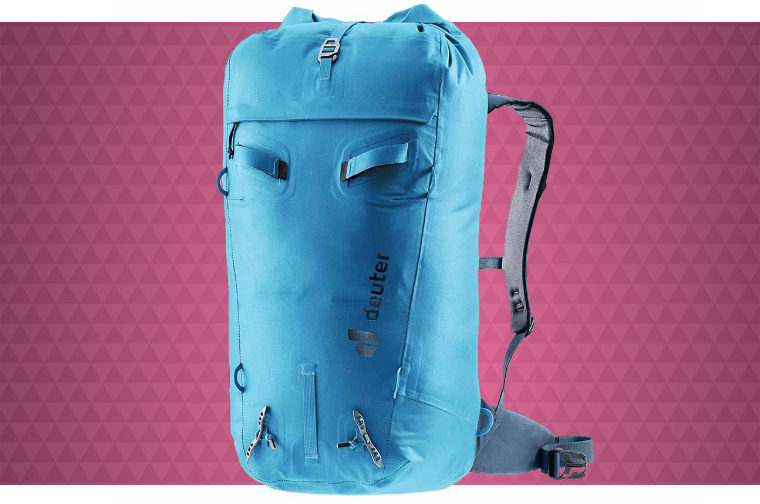

Deuter Durascent 30 Backpack
Of all the climbing backpacks on our list, the Deuter Durascent 30 Backpack is most similar to the below Patagonia Ascensionist. It’s extremely lightweight, considering its toughness, with a simple roll top entry system and a minimalist design in terms of pockets. Like the Ascensionist, it also has a stripped back alpine back system with fairly basic ventilation and padding whilst providing just enough comfort even when carrying a decent load.
However, where the Deuter Duracscent outshines the Ascensionist is its ability to keep all of its contents dry. Yes, the 220D Polyamide fabric is completely waterproof offering a whole load more versatility for climbing and mountaineering in wet and wintery conditions.
The pack also features rope attachment straps, a front zippered pocket, an internal zippered pocket, ice axe and hiking pole attachment points and loops to attach a helmet carrying net. Additionally, and rather usefully, the internal fabric is white which makes a huge difference when fishing around in the bottom of the pack for gear.
For more information read our full reveiw of the Deuter Durascent 30 Backpack.
Pros
- Waterproof
- White inside fabric makes it very easy to see contents of pack
- Excellent ice axe loops – easy to use with gloves on
- Has welded and taped seams
Cons
- Excessively long shoulder strap tails
- Front pocket is difficult to use when main pack is full
- Helmet attachment net has to be bought separately
- No side straps
Find the latest price at:
Deuter | Amazon

Osprey Mutant 38-Liter Backpack
Budget-priced backpacks that tick every box that needs ticking on the performance end of things are few and far between. So few, in fact, that the Osprey Mutant cuts a fairly lonely figure in the category of top-performing alpine packs that won’t break the bank. This pack is reasonably light, made with hard-wearing materials, features a bucket-style top-loading opening and is very comfortable with even heavy loads.
A few more “dialled-in” features make the Mutant a winner for high-mountain high jinks, too, namely a sturdy haul loop, streamlined design, removable compression straps, and the “FlapJacket” top closure which allows for lidless use when need be.
The Mutant is heavier than both the Patagonia Ascensionist and the Mountain Hardwear Scrambler 30, but in terms of value for money it’s more than a match for either.
Pros
- Affordable
- Full complement of features
- Very comfortable
- Bucket-style top loading
- Removable hood/lid
- Removable compression straps
Cons
- A little on the heavy side (2.5 lbs)
- Not ideal for crag use owing to top-loading design
Find the latest price on:
Osprey | Alpine Trek | Backcountry
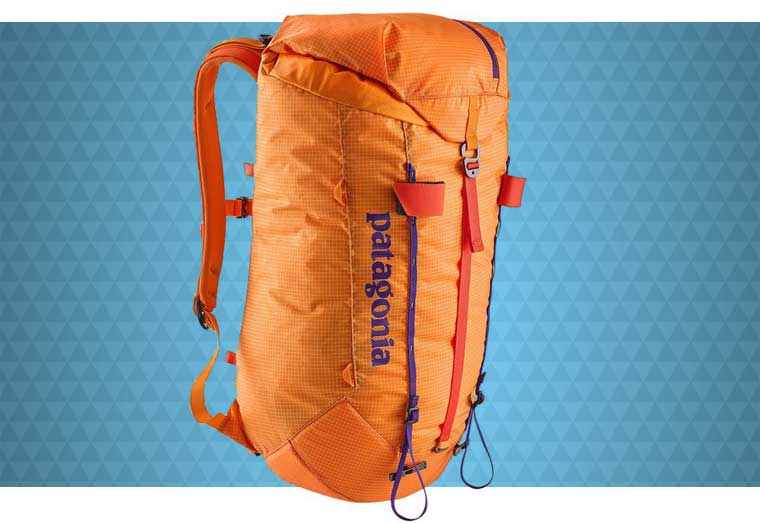
Patagonia Ascensionist 30 Pack
If you like to keep things super-light on your alpine adventures, the Patagonia Ascenionist may just be your bag. This pack weighs in at under two pounds—a remarkable feat given its hard-wearing, abrasion and tear-resistant Cordura nylon materials and surprisingly impressive comfort (don’t be fooled by the slender appearance of the cushioning on the straps and back panel!).
The top-loading design on this pack means its not the best option if you want to have it moonlight as a crag pack, but for multi-pitch and alpine routes its minimalist design and very loveable lack of poundage make it truly hard to beat.
Pros
- Incredibly light (1 lbs 7.6 oz)
- Hard-wearing Cordura materials
- Detachable hip belt
- Nicely padded back panel
- Daisy chains on rear of pack for external storage
Cons
- Top loading
- No side pockets
- Hood pocket very small
Find the latest price at:
Patagonia | Backcountry

Moon Climbing Aerial Pack Blue Jewel
The Aerial Blue Pack Jewel is a mid-sized climbing pack that’s ideal for one-day trips to the crag. It’s got tons of features that climbers will love, including a built-in rope tarp and easy-access wide-top opening.
However, despite its obvious climbing pedigree, this pack would also make a good hiking daysack or even minimalist weekend rucksack. The frame, harness, and padding mean it’s super-comfortable, and there are plenty of pockets and attachment points for all your essential gear.
Best of all, this is a rugged pack that is built to survive even the roughest, toughest conditions.
Pros
- Versatile
- Made from highly durable P600D ripstop
- Roll-top closure
- Integrated (removable) rope tarp
- Chest and waist harness
- Padded moulded foam backrest
- External compression straps
- Good storage options
Cons
- Quite heavy
- No environmental pedigree
Find the latest price on:
Moon Climbing | Alpine Trek

Mountain Hardwear Scrambler 30 OutDry Backpack
For single-day alpine adventures, they don’t come much better than the Mountain Hardwear Scrambler 30. This 30-liter pack isn’t the cheapest out there, but represents an upgrade on most cheaper alpine packs in terms of convenience and overall performance. It’s light, hydration compatible, tough as old leather, and features all the bells and whistles an alpinist could ask for: external gear loops, ice-ax loops, two large stow pockets on the side, a large hood pocket, a simply awesome suspension system and plenty of padding on she shoulders and hip belt.
What we like most about this pack, however, is the watertight OutDry construction and heat-sealed seams, both of which make it something of a standout amongst other packs in its price, weight, and performance range.
In short, an absolute winner for all things alpine! For morw information read our full review of the Mountain Hardwear Scrambler 30 OutDry Backpack.
Pros
- Light (1.7 lbs)
- External gear loops
- Waterproof
- Tough materials
- Hydration-bladder compatible
- Great suspension
- Ice-ax loops
Cons
- Side pockets are difficult to use when pack is full (not stretchy)
- Not as comfortable as other packs
Find the latest price on:
Mountain Hardwear | REI | Backcountry
Best crag and gym packs
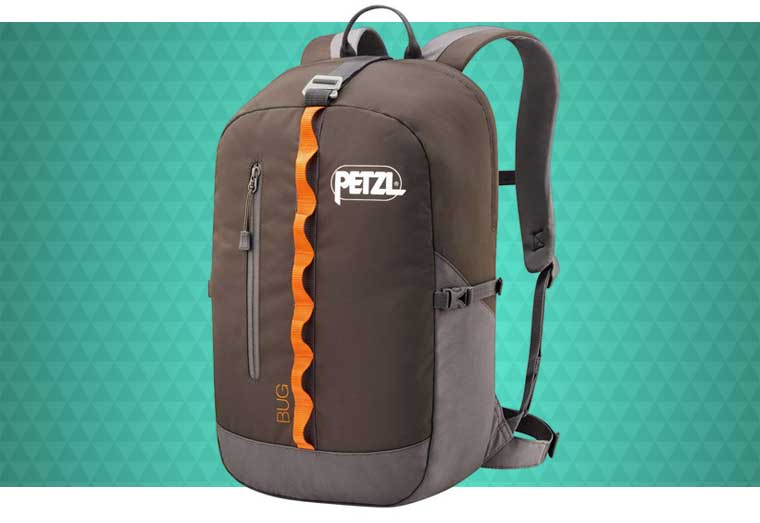
Petzl Bug 18L Backpack
If travelling light and fast is your thing, the 18-liter Petzl Bug merits its place somewhere near the top of your shortlist of potential purchases. As with all things Petzl, this pack is fantastically well made and something of a marvel of practicality. While a few would-be buyers might be put off by the Bug’s diminutive proportions and capacity, this shortage on the spatial front is made up for by a handful of external features that could add a pew precious liters of storage in a pinch, including a wide exterior pocket, a duo of compression straps that can double up as gear loops, and a full-length, MOLLE-style daisy chain on the rear of the pack.
What we like most about the Bug are the reinforced areas on the bottom and side of the pack and its super-snug, compact profile—unlike larger packs, this is one’s unlikely to snag on rocks or impede your movement in any way.
Pros
- Ergonomic fit holds pack snugly against your body
- Very well made
- Reinforced materials on base of pack
- Tough haul loop
- Higher hip belt leaves plenty of room for your harness
- Interior hydration-bladder sleeve
- Full-length daisy chain on rear of pack
- Foldaway waist belt
- Adjustable strap allows you to attach rope to the top of the pack
Cons
- Small capacity
- Pricey (poor price-to-volume ratio)
Find the latest price on:
Amazon | Alpine Trek | Backcountry

Ortovox Trad Zero 24 Backpack
Even empty climbing packs can be heavy. That’s because they’re constructed from heavy-weight materials and made to be strong and durable. Ortovox has gone a different route have produced one of the most lightweight climbing packs on this list, along with the Petzl Bug.
Using ripstop fabric and silicon lining, this is still a robust bag, but it’s far lighter than most of its competitors. However, at 24 litres, it’s also a fair bit smaller making is less suited to alpine missions. This is the ideal pack for climbers who have to hike a long way to the foot of the crag and don’t want to carry any more weight than is absolutely necessary.
Pros
420D lightweight ripstop polyamide construction
Removable pack plates and hip belt
Rolltop lid
Compression straps
Separate map compartment and valuables pocket
Daisy chain for accessories
External rope holder
Cons
Maybe too small for longer trips or trad climbers with loads of gear to carry
Not as well-padded as other packs on review
Find the latest price on:
Alpine Trek | Amazon
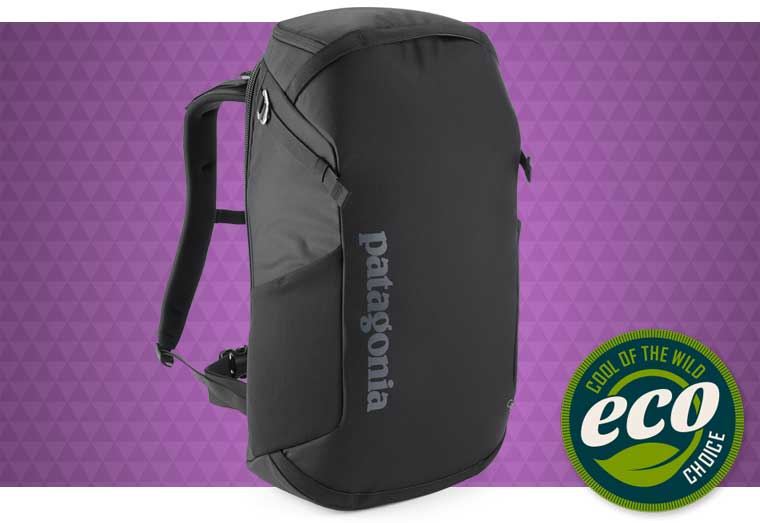
Patagonia Cragsmith 32L
Made with a 50% recycled nylon exterior Patagonia Cragsmith 32L is our favourite eco-friendly climbing backpack. Its hardy material is rip resistant and features a durable water repellent finish. Access to the main compartment is via the zippered back panel, this opens suit-case style, allowing for easy packing. A U-shaped top zipper allows quick access on the go. Additionally, the front and side panels are padded so the pack maintains its shape and structure even when empty. An inside zippered pocket is a safe place to keep your keys and wallet on the climb. The pack is also hydration bladder compatible and you can use the two stretchy side pockets to store you water bottle or guide book.
Pros
- Made from durable fabrics
- Easy access to the main compartment
- Sufficient attachment points for climbing gear
Cons
- 32L capacity may be a tight squeeze for some climbers
Find the latest price at:
Patagonia | REI | Alpine Trek

Mammut Neon Gear 45L Pack
For those who prefer to get their climbing underway with as little fuss and fiddling with straps and drawstrings as possible after the approach, we get our review of the best crag pack underway with an absolute winner.
The Mammut Neon Gear 45 offers a comfy carry on those often weary walk-ins and walk-outs, but when you arrive at your rock its combo top-loading and rear-entry design makes accessing all your gear an absolute cinch. The back panel of this pack can be opened in full and the interior is the climbing equivalent of a walk-in cupboard for your kit, boasting a large mesh pocket for you climbing shoes, a “chalk chamber”, a stowable rope tarp, and a very handy, large gear loop that lets you keep all your carabiners, quickdraws, and other gear pleasingly unjumbled.Other endearing touches to this pack are the tough, 420d fabric with 820d reinforcements on the base and sides, a nicely padded hip belt and shoulder straps, and an EVA foam back panel that provides plenty of ventilation while also preventing any pointy gear items poking you in the ribs while you walk.
At 3.15 pounds, this isn’t the lightest pack out there, but in terms of convenience and user-friendliness it’s truly hard to beat.
Pros
- Wealth of internal storage options
- Bucket-style top opening
- Back panel can be opened fully
- Very tough materials
- Very comfortable
- Stowable rope rug/tarp
Cons
- A little on the heavy side (3.15 lbs)
Find the latest price on:
Amazon | Alpine Trek | Backcountry
Black Diamond Creek 50 Pack
If you’re an everything-but-the-kitchen-sink kinda packer when it comes to hitting the crags, then the Black Diamond Creek 50 could well be the pack you’re looking for.
Not only does this pack boast a huge 50-liter capacity, however, but it also does just about everything you need to store that gear efficiently. The pack’s side zipper lets you squeeze gear in or yank it out without disturbing the rest of the pack’s contents and makes loading and unloading a piece of cake. Additionally, the rain hood doubles up as a helmet and rope holder and the large front flap includes internal, zippered organizer pockets.
What we like most about this pack is that it combines the best of a high-capacity haul pack (durability, tough materials, freestanding design) with the convenience of a duffel-style crag pack. It’s also very comfortable and has the added bonus of using waterproof fabrics and including a rain cover just in case.
While it may be a touch on the bulky side for those of a minimalist persuasion, for the rest of us this pack is pretty much perfect for use at the crag, gym, and even on the odd multi-pitch route if hauling a lot of gear.
Pros
- 50-liter capacity
- Side and top access
- Very tough materials (1200d polyester)
- Rain hood converts into helmet and rope holder
- Comfortable
- Waterproof
Cons
- Expensive
- Bulky
- Heavy 4 lbs 7 oz
Find the latest price on:
Amazon | REI | Alpine Trek | Backcountry
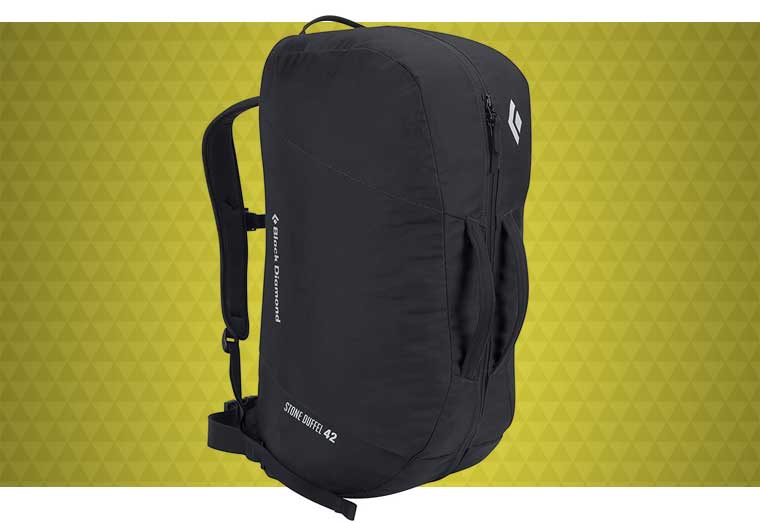
Black Diamond Stone Duffel 42
The Black Diamond Stone 42 Duffel is, in essence, a simple duffel bag with a few shoulder straps and hip belt thrown in for easy portation. While this may not sound like high or purchase-worthy praise, it does give us an idea of the pack’s most endearing characteristic and unique selling point: simplicity.The full frontal zipper on the Stone 42 makes loading and unloading easier than with any other pack in out review and its 42-liter capacity is more than enough for everything you could wish to take with you for a day of sport or trad climbing.
This isn’t a pack that you’d fancy using on an alpine route, granted, but for hitting the gym or crag it offers the sort of fuss-free functionality that even the fussiest of climbers crave when loading and unloading their gear.
Pros
- Cheap!
- 42-liter capacity
- Front-loading
- Duffel-style design
- Built-in (but removable) rope tarp
- Stowable shoulder straps
- Plenty of room for rope, quickdraws, and trad gear
Cons
- Lack of storage pockets beyond large central well/compartment
Find the latest price on:
Amazon | Alpine Trek | Backcountry
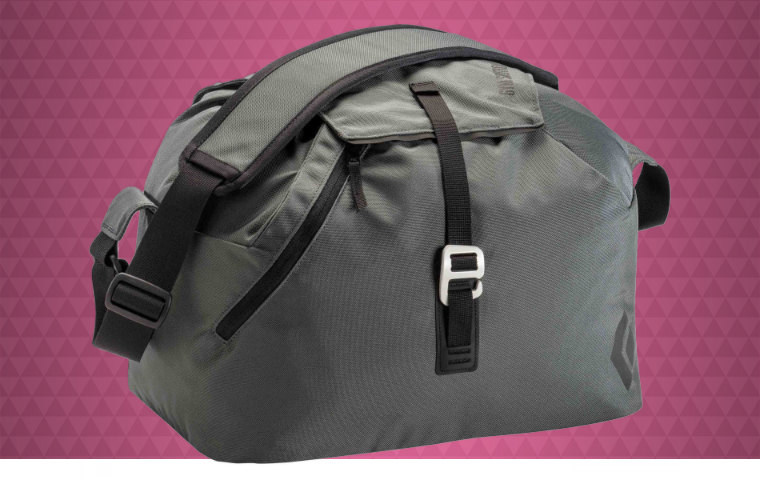
Black Diamond Gym Solution 35 Bag
It might not fall into the “badass” category of climbing accessories, but the Black Diamond Gym Solution Bag does practicality and convenience rather well. Instead of emptying all of your climbing kit out of your crag bag every time you plan on hitting the gym after work, this messenger-style satchel lets you keep all your indoor kit separate while adequately alerting your colleagues to the fact that you are a climber, even without the standard chalk- and blood-stained backpack to prove the point!
On a more serious note, this bag boasts plenty of space (35 liters) for your climbing shoes, belay shoes, harness, and other gear. It also offers a cheaper, more lightweight (27 oz) alternative to a backpack-style pack for those who just want the option of lobbing their gear into an easily accessible bag when making their way to the indoor wall.
Pros
Enough space for a rope as well as your other gear
Functional
35-liter capacity
Cons
Scores a fairly lowly 2 or 3 on the Badass-ometer
Not suited to outdoor use, unless you don’t have far to walk to the crag
Find the latest price on:
Amazon | REI
How to choose a backpack for climbing
Climbing backpack vs hiking backpack
The main point of divergence between climbing and hiking packs exists in convenience. The ideal climbing pack will offer easy access to your rope and gear by way of a front-loading or bucket-style top-loading design. The best of the bunch also usually include a few other climber-friendly features such as gear loops, solid suspension for heavy loads, compartments for shoes, chalk, quickdraws and trad gear, a rope tarp, and reinforced material on the base of the pack. All this usually makes climbing packs a touch heavier (except in the case of alpine models, which are more “bare-bones” in character), but far more durable and practical.
Crag pack vs alpine pack vs gym pack
The ideal climbing pack for you will depend large on exactly what you get up to when you put on your climbing shoes. The differences between crag, alpine and gym packs may seem subtle at a first glance but they can make a huge difference to performance and overall functionality.
The ideal crag pack should be spacious enough for all your hardware and have either a front-loading design or feature a bucket-style top-loading system that allows for easy access to your ropes and kit. If most of the crags you head to are near the roadside or without huge approaches, you can afford to compromise a little on comfort.
Alpine packs need to be light, durable, not too bulky, and have a handful of small features—a detachable belt, gear loops, and a daisy chain on the exterior, for example—that make them “dialled in” to the nature and needs of alpine climbing. If you envision doing any hauling, a sturdy haul loop and thicker, abrasion-resistant materials become of the essence.
Gym packs were once considered just a ruse of the marketing people at the big brands conceived to make us part with more of our hard-earned pennies. While there’s a certain element of truth to this, there’s no denying they have their uses and can be far more convenient than backpacks or duffel-style packs for many gym-goers.
The definition of a gym pack could be fairly wide if we were to include crag-style gym packs, but for the purposes of this review we’ll stick to the more recent, tote or messenger-style bags that are now becoming a common feature at indoor climbing walls the world over. For the most part, these packs are fuss and frill-free affairs that don’t do a great deal more than your average large grocery-shopping bag but last a lot longer, look a lot more stylish, and let you keep your gym gear separate from your regular climbing kit for those days when you just want to hit the polyurethane resin hold for an hour or two after work without upending your neatly ordered climbing cupboard in the process.
Conclusion
The pack that will ultimately prove to be “The One” for your adventures on the rock will, of course, depend on what you’re going to be getting up to. If, however, you end up with any of those featured on the above list we’re sure that you’ll have yourself a trusty, reliable, ready-to-rock climbing companion that will serve you well for many years to come!


